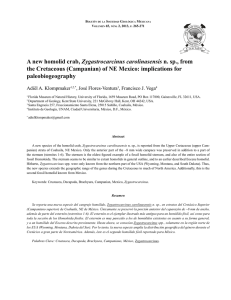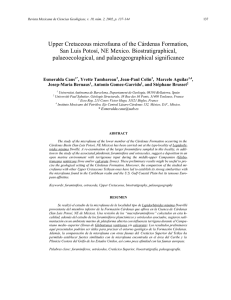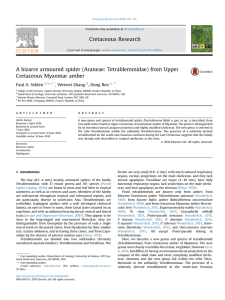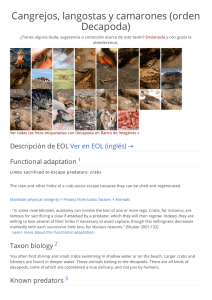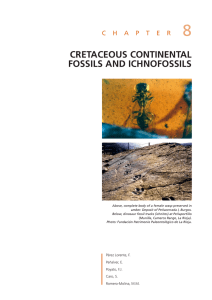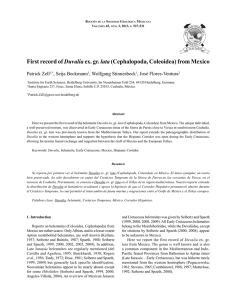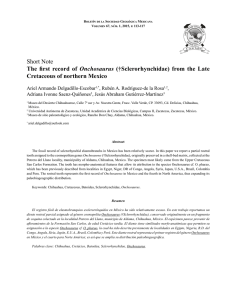New crabs (Crustacea, Decapoda) from the Upper Cretaceous
Anuncio
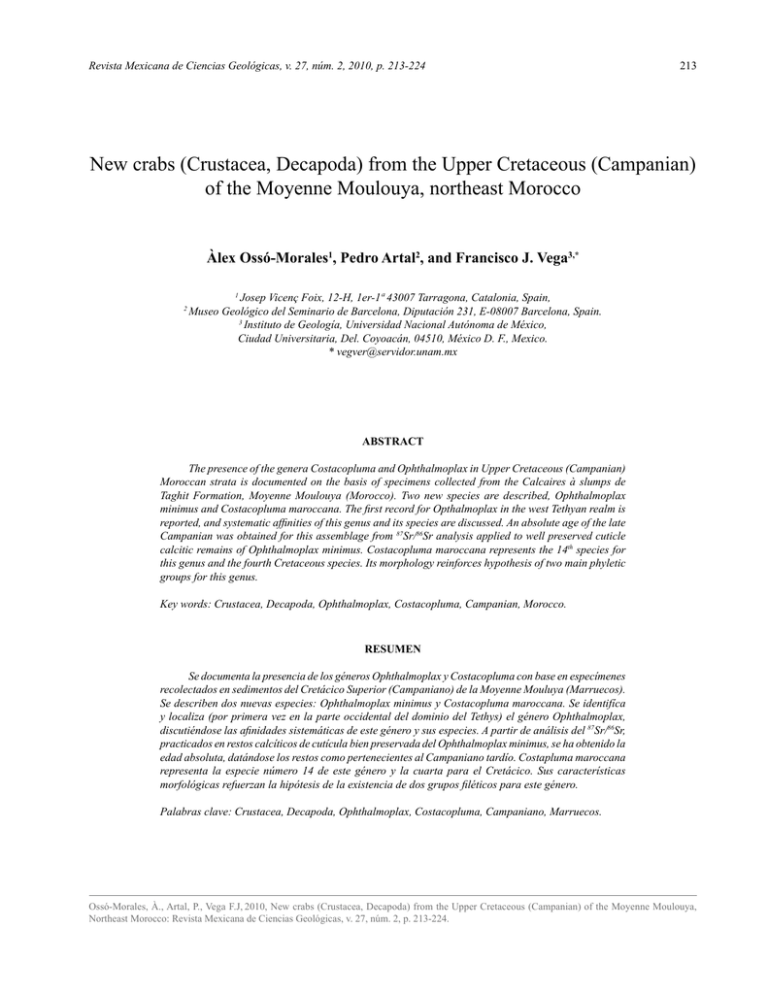
Revista Mexicana de CienciasNew Geológicas, v. 27, 2010, p. 213-224 crabs from the núm. Upper2,Cretaceous of the Moyenne Moulouya, Morocco 213 New crabs (Crustacea, Decapoda) from the Upper Cretaceous (Campanian) of the Moyenne Moulouya, northeast Morocco Àlex Ossó-Morales1, Pedro Artal2, and Francisco J. Vega3,* 2 1 Josep Vicenç Foix, 12-H, 1er-1ª 43007 Tarragona, Catalonia, Spain, Museo Geológico del Seminario de Barcelona, Diputación 231, E-08007 Barcelona, Spain. 3 Instituto de Geología, Universidad Nacional Autónoma de México, Ciudad Universitaria, Del. Coyoacán, 04510, México D. F., Mexico. * [email protected] ABSTRACT The presence of the genera Costacopluma and Ophthalmoplax in Upper Cretaceous (Campanian) Moroccan strata is documented on the basis of specimens collected from the Calcaires à slumps de Taghit Formation, Moyenne Moulouya (Morocco). Two new species are described, Ophthalmoplax minimus and Costacopluma maroccana. The first record for Opthalmoplax in the west Tethyan realm is reported, and systematic affinities of this genus and its species are discussed. An absolute age of the late Campanian was obtained for this assemblage from 87Sr/86Sr analysis applied to well preserved cuticle calcitic remains of Ophthalmoplax minimus. Costacopluma maroccana represents the 14th species for this genus and the fourth Cretaceous species. Its morphology reinforces hypothesis of two main phyletic groups for this genus. Key words: Crustacea, Decapoda, Ophthalmoplax, Costacopluma, Campanian, Morocco. RESUMEN Se documenta la presencia de los géneros Ophthalmoplax y Costacopluma con base en especímenes recolectados en sedimentos del Cretácico Superior (Campaniano) de la Moyenne Mouluya (Marruecos). Se describen dos nuevas especies: Ophthalmoplax minimus y Costacopluma maroccana. Se identifíca y localiza (por primera vez en la parte occidental del dominio del Tethys) el género Ophthalmoplax, discutiéndose las afinidades sistemáticas de este género y sus especies. A partir de análisis del 87Sr/86Sr, practicados en restos calcíticos de cutícula bien preservada del Ophthalmoplax minimus, se ha obtenido la edad absoluta, datándose los restos como pertenecientes al Campaniano tardío. Costapluma maroccana representa la especie número 14 de este género y la cuarta para el Cretácico. Sus características morfológicas refuerzan la hipótesis de la existencia de dos grupos filéticos para este género. Palabras clave: Crustacea, Decapoda, Ophthalmoplax, Costacopluma, Campaniano, Marruecos. Ossó-Morales, À., Artal, P., Vega F.J, 2010, New crabs (Crustacea, Decapoda) from the Upper Cretaceous (Campanian) of the Moyenne Moulouya, Northeast Morocco: Revista Mexicana de Ciencias Geológicas, v. 27, núm. 2, p. 213-224. 214 Ossó-Morales et al. INTRODUCTION and Talsint in northeast Morocco, within the Plis Marginaux at the Moyenne Moulouya region (Figures 1 and 2). The Calcaires à slumps de Taghit Formation was established for the zone situated between Tizi Zaoumit and Ras Rcheg, with a range of Coniacian-Campanian; it overlies the Calcaires de Tizi Zaoumit Formation, which comprises the Cenomanian-Turonian interval (Charroud, 2002) (Figure 3). The fossiliferous outcrops consist of yellow calcareous marls with scarce macrofauna (Figure 4). Complete absence of index fossils (microfossils, ammonoids, rudists, etc.) makes it difficult to define a biostratigraphic age. However, studies on the stratigraphy and general geology from nearby areas (Enßlin, 1993; Charroud, 2002; Haddoumi et al., 2008) indicate an Upper Cretaceous sedimentary sequence for the regional lithostratigraphic units. With the aim to resolve the chronological uncertainty of the strata where the fossil crustaceans were found, we obtained 87Sr/86Sr isotopic analyses on carapace fragments of Ophthalmoplax minimus new species. The carapace fragments were extracted by handpicking and its chemical composition was analyzed by X-ray diffraction at the Laboratorio de Difracción de Rayos X, Instituto de Geología, UNAM, Formal reports on fossil decapod crustaceans from Africa are very scarce, in particular those from Morocco (Secretan, 1961; Garassino et al., 2007). The present study is a contribution to the systematic, paleobiogeographic and evolutionary knowledge of Late Cretaceous decapod crustaceans from the Tethyan realm, and documents the presence of Ophthalmoplax Rathbun, 1935, previously considered as an exclusively Pan-American genus. Our knowledge on the distribution patterns, endemism and origins of crustacean decapod taxa is expanding rapidly, and drastic changes are being experienced in the way we understand the evolution of this interesting group. The Ibericancridae Artal, Guinot, Van Bakel and Castillo, 2008, a new brachyuran family closely related with what was once considered an exclusively American group (Dakoticancridae Rathbun, 1917, see Bishop et al., 1998), was recently reported for the upper Campanian of Spain (Artal et al., 2008). The crustaceans herein described were collected from the Calcaires à slumps de Taghit Formation that crops out near to the village of Merija, between the cities of Missour 38 PORT. SPAIN 36 Tangier Ceuta (SP.) Mediterranean Sea Tètouan Melilla (SP.) Oujda Kenitra Rabat 34 Casablanca Fès Mohammedia Meknès El Jadida North Atlantic Ocean 32 Bou Arfa Safi Marrakesh Quarzazate Agadir 30 o ALGERIA Tan-Tan 28 0 Western Sahara N W 12 10 0 200 km 100 100 200 mi MAUR. 8 6 4 2 0 Figure 1. Location map on northwest Africa, Morocco. Rectangle area with star correspond to Figure 2. New crabs from the Upper Cretaceous of the Moyenne Moulouya, Morocco 215 Missour Talsint Beni Tajjite 5mi 10km Figure 2. Location map of fossil locality (star) at Plis Marginaux at the Moyenne Moulouya area, northeast Morocco. with a result of 100% calcite. The calcite is considered to be of primary origin based upon its mineralogy and textural preservation. The measurement of the 87Sr/86Sr ratio was made by mass spectrometry with a thermal ionisation mass spectrometer Finnigan MAT 262, after acid digestion and cation exchange separation, all processed at the Laboratorio Universitario de Geoquímica Isotópica, Instituto de Geología, UNAM. We obtained a value of 87 Sr/86Sr = 0.707595 ± 0.000028 (one standard deviation) for a run of 58 measurements. By comparison with the 87 Sr/86Sr seawater curve for the Late Cretaceous– Paleogene (McArthur and Howarth, 2004), the obtained isotopic ratio corresponds to an age of the late Campanian (approximately 76 Ma; Figure 5). The associated fauna includes small oysters and echinoids, mainly Goniopygus sp. and Mecaster fourneli Deshayes, in Agassiz and Desor, 1847. Goniopygus has been usually assigned to Goniopygus durandi in Cotteau, Peron and Gauthier, 1881 (Petitot, 1959), but the current attribution of this species has been questioned (Gallemí, pers. comm.). The presence of oysters and echinoids, together with the eustatic conditions for the Upper Cretaceous deposits, suggests a shallow marine environment from the Coniacian to the Campanian in the study area. Previous studies suggest a markedly regressive cycle, and the connection to an Atlantic realm more than a Tethyan influence (Charroud, pers. comm.). Specimens are deposited in the paleontological collection of the Museo Geológico del Seminario de Barcelona, under acronym MGSB, and in the Museo Civico di Storia Naturale di Milano, under acronym MSNM. SYSTEMATIC PALEONTOLOGY Order Decapoda Latreille, 1802 Infraorder Brachyura Latreille, 1802 Superfamily Portunoidea Rafinesque, 1815 Family Macropipidae Stephenson and Campbell, 1960 Genus Ophthalmpoplax Rathbun, 1935 Type species. Ophthalmoplax stephensoni, Rathbun, 1935, by original designation. Ophthalmoplax minimus new species Figure 6 Diagnosis. Carapace small, transversely subtrapezoidal in outline, orbito-frontal margin large, with triangular supramarginal spines fairly directed upwards; dorsal surface longitudinally convex, somewhat less in transverse section; orbits large; front relatively narrow, strongly deflexed, with robust, salient orbital nodes and bifid tip; lateral margins of carapace arched, with stout spines; dorsal surface bearing acute transverse ridges on gastric, branchial and cardiac regions; stenum large, subcircular, with sternite 3 extending laterally; male abdomen not totally covering sternites 7 and 8; eyestalks long, chelipeds large, with short spines on ventral and dorsal margins of palm; palm ridged on lateral surface. Etymology. From the latin minimus, in reference to the reduced size of carapaces, compared with the large size in other species. Description. Carapace small to medium in size, transversely 216 Coniacian - Campanian Calcaires à slumps de Taghit Cenomanian - Turonian Calcaires de Tizi Zaoumit lower Cenomanian Ossó-Morales et al. Marnes à gypse Figure 3. Stratigraphic units that crop out in the study area, including the position of level with crustaceans. No vertical scale. Modified after Charroud, 2002. subtrapezoidal in outline, somewhat broader than long, maximum width at the level of epibranchial region; dorsal surface fairly convex in longitudinal section. Orbito-frontal margin notably large, bearing a reduced fissure with angular marginal corners and a subtriangular tooth markedly directed upwards, close to the outer orbital spines which are stout, robust, with triangular base. Front relatively narrow, deflexed, with salient orbital nodes and bifid termination. Anterolateral margins short, slightly concave, with cervical notch. Posterolateral margins longer, arched, bearing four large spines or tubercular nodes, and two additional smaller ones between first and second spines. Posterior margin noticeably shorter than orbito-frontal margin, straight, weakly rimmed. Swellings and furrows define dorsal regions of carapace. Mesogastric region large, subpentagonal, with anterior process narrow, long bounded by weak furrows; ridge at medial portion. Protogastric lobes large, inflated, with transverse ridge. Epigastric lobes small, defined by two small swellings. Anterior epibranchial lobes slightly inflated, leading to a robust marginal spine, posterior lobes inflated, oblique, axially bounded by branchiocardiac furrow. Mesobranchial regions large, with two marginal nodes and short transverse ridges. Metabranchial regions small, with short transverse crest. Cardiac region large, inverted subpentagonal in shape; medial ridge, protuberance present at lower corner. Intestinal region depressed. Pterygostomial regions small, subtriangular, rimmed. Buccal frame large. Sternum large, subcircular. Sternites 1-2 subtriangular, small. Sternite 3 salient, extending laterally, axially depressed. Small notch separating sternites 3 from 4. Sternite 4 with raised oblique margins. Sternites 5 to7 decreasing in size posteriorly, with long episternites directed backwards. Abdomen sexually differentiated. Narrow in males, subtriangular, not totally covering sternites 7-8; telson triangular; pleomere 6 subtrapezoidal; pleomere 5 subsquare, as wide and long as pleomere 6; pleomere 4 subrectangular elongated, slightly shorter and narrower than pleomere 5, with median ridge; pleomere 3 broader, extending laterally. Broad, suboval abdomen in females; telson broad, subtriangular; pleomere 6 subtrapezoidal, one-third wider but one-fouth shorter than telson; pleomere 5 rectangular, one third the length and nearly as wide as pleomere 6, with median transverse ridge; pleomere 4 very similar to pleomere 5; pleomere 3 nearly as wide but slightly shorter than pleomere 4, concave on median portion of anterior margin, with median transverse ridge; pleomere 2 one-third narrower than pleomere 3, with median transverse ridge. Chelipeds robust, basis-ischium fused, merus robust and long with tubercles on inner surface; carpus with denticled surface, palm long, robust, outer surface medially ridged, margins profusely spinose; dactily spinose, with robust inner denticles; first tooth of mobile finger stout and extremely long on right cheliped. Pereiopods 2 to 5 long, flattened. Lateral surface covered by large, spaced granules. Material. Holotype MSGB74546; paratypes MGSB74547a, MGSB74547b and MGSB74547c. Measurements (in mm). Holotype MSGB74546, carapace length = 23, width = 26, orbito-frontal width = 25; paratypes MGSB74547a, carapace length = 21, width = 23, orbitofrontal width = 21; paratype MGSB74547b , carapace length = 31, carapace width = 33, orbito-frontal width = 30; MGSB74547c, carapace length = about 50. Genus discussion. Ophthalmoplax has been reported from the Upper Cretaceous Atlantic and Gulf Coast of the SE of North America (South Carolina, Alabama, Mississippi, Texas, Coahuila, Nuevo León) (Rathbun, 1935; Stenzel, 1952; Vega and Feldmann, 1991, as Mascaranada; Schweitzer et al., 2007; Vega et al., 2007) and also from the Upper Cretaceous of South America (Colombia, Venezuela, New crabs from the Upper Cretaceous of the Moyenne Moulouya, Morocco a) 217 b) Figure 4. Fossiliferous beds of the Calcaires à slumps de Taghit Formation. a: Landscape of Moyenne Moulouya area. Arrow points at outcrop of next photograph. b: Outcrop from which crabs were collected. Brazil) (Maury, 1930, as Zanthopsis; Beurlen, 1958; 1965 as Archaeopus; Feldmann and Villamil, 2002; Souza-Lima et al., 2003; Aguilera et al., 2010). Feldmann et al. (1999) described Ophthalmoplax spinosus from the Turonian of Colombia; however, Guinot et al. (2008) considered it to be Cenomanocarcinus vanstraeleni Stenzel, 1945. All of the stratigraphic occurrences for Ophthalmoplax in America correspond to Maastrichtian lithostratigraphic units, except for O. triambonatus Feldmann and Villamil, 2002 assigned to upper Turonian sediments of the Puerto Romero Formation in the north-central part of the Middle Magdalena River Valley, Colombia; in their report, Feldmann and Villamil (2002, p. 718) commented: “Baculitid ammonites encountered in association with the crab specimens are possibly of Maastrichtian age (Etayo, pers. comm.); however, baculites are poorly known for this region of South America and the age is not reliable”. Their interpretation for a Turonian age is then based on bivalves and foraminifera that suggest an age not younger than Coniacian; however, other foraminifera from the study section indicated a Campanian age (Feldmann and Villamil, 2002, p. 720). Nevertheless, other stratigraphic studies suggest a late Maastrichtian age for the Puerto Romero Formation (Vásquez et al., 2000). A summary of current status of species described as Ophthalmoplax is presented in Table 1. Schweitzer et al. (2007) considered the following species of Ophthalmoplax: O. stephensoni Rathbun, 1935; O. brasiliana (Maury, 1930); O. comancheensis Rathbun, 1935; O. triambonatus Feldmann and Villamil, 2002; and questionably O. spinosus Feldmann et al. (1999). Similarities between O. brasiliana and O. triambonatus were noticed by Feldmann and Villamil (2002, p. 273), and used differences in shape of carapace and degree of development of dorsal regions of carapace to define a new species. However, the sole type specimen of O. triambonatus is deformed, and thus differences observed may be result of such deformation. Large specimens of O. stephensoni from Maastrichtian deposits of NE Mexico are under study, but show that such large forms of Ophthalmoplax were present in the Tethyan realm during Maastrichtian times. Ophthamoplax comancheensis was described on the basis of small movable and fixed fingers that according to Rathbun (1935, p. 54) “…resemble those of O. stephensoni more than any other Cretaceous species”. Based on the stratigraphic occurrence of O. comancheensis in Albian deposits of Texas, Feldmann and Schweitzer (2006) considered an origin of this genus during the Early Cretaceous. Similarity with Archaeopus rathbunae Beurlen, 1965 from the Albian of Brazil and members of the Carcineretidae has been suggested (Vega and Feldmann, 1992). The inverted subtrapezoidal shape of the Figure 5. Curve of seawater strontium isotopic composition for the Late Cretaceous and Paleogene (after McArthur and Howarth, 2004). The grey bars indicate the 86Sr/87Sr ratio obtained for carapace fragments of Ophthalmoplax minimus new species and the corresponding late Campanian age. Sr isotopic ratios were measured by the method described in the text. 218 Ossó-Morales et al. Figure 6. Ophthalmoplax minimus new species, Calcaires à slumps de Taghit Formation, upper Campanian, Morocco. 1: Holotype MGSB74546, dorsal view of carapace with left cheliped and pereiopods; 2: Fontal view of carapace, same specimen; 3: Paratype MGSB74547c, ventral view of male carapace; 4: Paratype MGSB74547b, dorsal view of female carapace; 5: Ventral view of female carapace, same specimen; 6: Frontal view of female carapace, same specimen; 7: Paratype MGSB74547c, right chela of male specimen. Scale bar = 1 cm. New crabs from the Upper Cretaceous of the Moyenne Moulouya, Morocco 219 Table 1. Stratigraphic and geographic distribution of species of Ophthalmoplax, including current and suggested systematic status for each species. Species Age Locality Current/Suggested status Ophthalmoplax stephensoni Ophthalmoplax stephensoni Maastrichtian SE USA O. brasiliana O. triambonatus O. spinosus O. minimus Maastrichtian Maastrichtian Turonian Campanian Brazil, Venezuela Colombia Colombia NW Africa Mascaranada difuntaensis Maastrichtian NE Mexico carapace and the bifid rostrum resembles Ophthalmoplax, but the small size (18×15 mm) and the inclined epi- and mesobranchial ridges makes it different. The sharp, inclined ridges recall those of Branchiocarcinus Vega, Feldmann and Sour-Tovar, 1995, from the Maastrichtian of NE Mexico, but the epibranchial ridges are inclined in a different direction. A direct observation of the holotype is needed in order to define if “Archaeopus” rathbunae is the oldest representative of this carcineretid/portunid group. Based on morphological similarities between Ophthalmoplax and Bathynectes Stimpson, 1871 and Raymaninnus Ng, 2000, genera of the Subfamily Polybiinae Ortmann, 1893, Schweitzer et al. (2007) removed Ophthalmoplax from the Carcineretidae Beurlen, 1930, to include it into the Portunidae. Later, Karasawa et al. (2008) included Ophthalmoplax into the Macropipidae. Although we agree in this systematic placement, there are some features to be discussed for a future review of the familiar affinity of Ophthalmoplax. Carapace morphology of the extant genera referred to the Macropipidae is not so similar to Ophthalmoplax, whose flattened fifth pereiopods are most similar to members of the Portunidae Rafinesque, 1815. Also, Bathynectes and Raymaninnus have transverse dorsal ridges relatively similar to Ophthalmoplax, but their anterolateral margins bear two to four sharp spines, the orbits are smaller, rostrum with two sharp spines, female telson is smaller and triangular and the male abdomen wider at its base, among other differences. In commenting the systematic affinity of Ophthalmoplax to the Macropipidae, Karasawa et al. (2008, p. 102) stated: “The extinct members of the family form a remarkably homogenous group in terms of dorsal carapace morphology with the exception of Ophthalmoplax, the only Cretaceous form. However, the features of the male sternum and abdomen of Ophthalmoplax are remarkably congruent with those of the other members of the family.” In our opinion, the combination of a subtrapezoial, flattened carapace, sharp transverse ridges on dorsal carapace, bifid rostrum, sharp, inclined outer orbital spine, male abdominal segments keeled, female abdominal segments smooth and spinose dorsal and ventral chelipeds margins may justify to keep Ophthalmoplax into a different subfamily. At this moment, we follow Karasawa et al. (2008), confirmed by a more recent classification (De Grave et al., 2009) that place Ophthalmoplax as part of the Macropipidae. O. stephensoni O. stephensoni Cenomanocarcinus vanstraeleni Ophthalmoplax minimus O. stephensoni Species discussion. Ophthalmoplax minimus new species differs from other species of the genus by the following combination of characters: smaller size of the carapace; outer orbital and anterolateral spines proportionally smaller; protogastric process stronger, dividing protogastric transverse ridge; cardiac ridge not so sharp; intestinal region clearly defined; male abdomen proportionally wider; and dorsal and ventral margins of chelae with not so developed sharp spines. The late Campanian record of O. minimus new species may represent the oldest record for the genus, and suggest a possible African origin, with a westward migration across the proto-Atlantic, to rapidly spread along the northeast coast of South America and the southeast coast of North America. The absence of Ophthalmoplax in Maastrichtian sediments of southern Mexico and the Caribbean region may have been due to competition, habitat preference (most Maastrichtian deposits with decapod crustaceans in southern Mexico and the Caribbean are reefal, in contrast with the terrigenous deposits of SE North America and NE South America), preference for more temperate waters, or a combination of those elements. Superfamily Retroplumoidea Gill, 1894 Family Retroplumidae Gill, 1894 Genus Costacopluma Collins and Morris, 1975 Type species. Costacopluma concava Collins and Morris, 1975, by original designation. Costacopluma maroccana new species Figure 7 Diagnosis. Carapace of moderate size, transversely suboval to rounded subhexagonal in outline; wider at posterior half of the carapace; orbito-frontal margin long; front narrow, bifid, slightly to fairly downturned; orbit large; anterolateral margins very short; posterolateral margins longer, broadly arched; posterior margin wider than orbito-frontal margin; lateral flanks nearly at right angles from dorsal surface; dorsal surface bearing a set of transverse crests, with top of ridges from sharp to slightly rounded; dorsal regions swollen, ornamented with ridges; cervical furrow well-defined 220 Ossó-Morales et al. Figura 7. Costacopluma maroccana new species, Calcaires à slumps de Taghit Formation, upper Campanian, Morocco. 1: Holotype MGSB74544, dorsal view of carapace; 2: Ventral view of carapace, same specimen; 3: Frontal view of carapace, same specimen; 4: Paratype MGSB74545b, dorsal view of carapace; 5: Ventral view of carapace, same specimen; 6: Paratype MSNMi27216, dorsal view of carapace with right and left chelipeds; 7: Ventral view of carapace, same specimen; 8: View of right and let chelipeds, same specimen. Scale bar = 1 cm. 221 New crabs from the Upper Cretaceous of the Moyenne Moulouya, Morocco Table 2. Stratigraphic and geographic distribution of the two groups of species of Costacopluma. Group A is represented by species of small to medium size, with an ovate carapace shape, wider than long. Group B includes small species, with an inverted subtrapezoidal carapace. Species CRETACEOUS GROUP A Coniacian-Santonian Costacopluma bishopi C. concava C. maroccana n. sp. C. mexicana C. grayi Mexico Campanian Nigeria - India Morocco GROUP B C. senegalensis C. binodosa C. bifida C. nordestiana C. australis C. salamanca C. texana C. squiresi at lateral margins; mesogastric region large, subrhomboidal in shape; protogastric lobes fairly swollen; cardiac region extremelly large, subpentagonal inverted in shape; sternum broad, anterior portion (sternites 3-4) subtrapezoidal, posterior portion (sternites 5-7) transversely subrectangular, strongly ridged; oblique deep depressions separating sternite 3 from sternite 4; eyestalks long. Etymology. Named after Maroc (Morocco), country of collection. Description. Carapace of medium size for the genus, transversely suboval in outline, broader than long; dorsal surface convex in both directions, maximum width at the posterior half of the carapace, at level of postbranchial regions. Orbito-frontal margin long, with robust outer orbital spines directed forward; dorsal border sinuous, infraorbital margin terminating in long and conical spine. Eyestalk very long, slender, subcylindrical. Front relatively narrow, with bifid tip, downturned, lateral margins fairly concave, broadening distally to a two divergent rounded lobes. Anterolateral margins short, nearly straight. Cervical notch well-marked at lateral margins and sides of carapace. Posterolateral margins longer than anterolateral margins, broadly arched. Lateral sides (flanks of carapace) from extraorbital spine to posterior margin, situated at about right angles from dorsal surface. Posterior margin convex, with axial portion nearly straight, noticeably longer than orbito-frontal margin. Dorsal regions well defined by swellings and depressions, crossed by a set of three transverse crests. Anterior crest markedly sinuous, with convex lateral portions directed forwards and axial portion forwardly concave. Two median crests nearly straight, obliquely directed from lateral margins to branchiocardiac furrow, being fairly interrupted by mesogastric lobe. Posterior crest relatively well-defined by lateral branchial swellings and a tranverse ridge in cardiac region. Mesogastric region large, subrhomboidal in shape, weakly separated from protogastric regions, bounded by PALEOGENE Maastrichtian Paleocene Mexico Eocene Alabama Senegal Greenland Venezuela Brazil Argentina Argentina Texas California posterolateral deep furrows. Protogastric regions large, swollen, crossed by anterior crest. Small epigastric swellings present at base of front. Branchial regions fairly swollen. Cardiac region well-defined, large, subpentagonal inverted in shape, bounded by shallow but evident branchiocardiac furrow; median portion of cardiac lobe crossed by a strong transverse crest that may be more or less rounded or ridged by preservation/deformation, inferior portion bearing a small protuberance. Intestinal region depressed. Dorsal surface with numerous granules mainly at top of inflations of regions and densely pitted at depressions. Sternum large, anterior portion (sternites 3-4) subtrapezoidal, posterior portion (sternites 4-7) transversely subrectangular. Sternite 3 swollen, axially depressed, separated from sternite 4 by a weak notch and oblique depressions. Sternite 4 large with oblique margins, gynglyme for the first pereipod fairly re-entrant. Sternites 5 to 7 transversely disposed, strongly ridged, with spaced granules. Sternoabdominal cavity relatively deep, fairly narrow in males. Abdomen narrow in males, subtriangular in shape. All pleomeres free, with medial transverse ridges. Pleomere 6 with salient posterior portion for abdominal holding system. Telson slightly elongated, rounded distally. Buccal frame large; third maxiliped large. Chelipeds robust, palm relatively large, somewhat flattened dorsoventraly; dactyli long and slender, inner teeth robust. Merus short; carpus long, globular. Pereiopods 2 to 4 fairly long, flattened. Pereiopod 5 not seen. Material. Holotype MGSB74544; paratypes MSGB74545a, MSGB74545b, MSNMi27216. Measurements (in mm). Holotype MGSB74544, carapace length = 19, width = 23, orbito-frontal width = 14; paratypes MGSB74545a, carapace length = 15, width = 19, orbitofrontal width = 11; MGSB74545b, carapace length = 19, width = 25, orbito-frontal width = 15; MSNMi27216, carapace length = 19, width = 25, orbito-frontal width = 16. Discussion. To the moment, 13 species of Costacopluma 222 Ossó-Morales et al. have been reported from Upper Cretaceous and Paleogene sediments of America, Greenland, West Africa, India and Europe (Table 2). Most species are known from Paleogene deposits of Venezuela (C. bifida Collins, Higgs and Cortitula, 1994), Brazil (C. nordestiana Feldmann and Martins-Neto, 1995), Argentina (C. australis Feldmann, Casadío ChirinoGálvez, and Aguirre-Urreta, 1995; C. salamanca Feldmann, Rodríguez, Marínez and Aguirre-Urreta, 1997), Senegal (C. senegalensis [Rémy in Gorodiski and Rémy, 1959]), Alabama (C. grayi Feldmann and Portell, 2007), Texas (C. texana Armstrong, Nyborg, Bishop, Ossó-Morales and Vega, 2009), California (C. squiresi Nyborg, Vega and Filkorn, 2009) and Hungary (Costacopluma sp. [Müller and Collins, 1991]) . The first report for a Paleocene species from the Pacific slope has recently been published from California (Nyborg et al., 2009). It is interesting to note that all Paleocene species are of small size (about 1 cm in width), while Cretaceous species tend to be larger, with the exception of the Coniacian C. bishopi Vega and Feldmann, 1992, with a mean width of 4 mm and C. binodosa Collins and Rasmussen, 1992 from the Campanian of Greenland. Small size has been interpreted as a response to environmental stress (Fraaije et al., 2006; Amstrong et al., 2009). The origin and paleobiogeographic distribution patterns of Costacopluma are still a matter of debate. McLay (2006) suggested that only four species of Costacopluma should be considered true retroplumids. A discussion on interpretations of this author are given by other authors (Armstrong et al., 2009; Nyborg et al., 2009). It is important to note existence of two main morphologic groups that embrace all of the described species of Costacopluma. The first group (Group A, Table 2) includes species with an ovate carapace, comprising species from the Cretaceous to the Eocene of Africa and America, while second group (Group B, Table 2) includes species with a subhexagonal to inverted subtrapezoidal carapace, comprising only Paleocene species from America. A closer morphological study of all of the species within this genus is needed in order to define if it is pertinent to formally subdivide in these two groups all the species of Costacopluma. Presence of this genus in Campanian sediments of NW Africa is expected, on the basis of the occurrence of C. concava Collins and Morris, 1975 in the Maastrichtian of North India (Gaetani et al., 1983) and Coniacian to ?Maastrichtian (mostly Campanian) sediments of Nigeria (Collins and Morris, 1975, altough no lithostratigraphic unit is mentioned by these authors, and recent regional stratigraphic reports must be reviewed in order to define the stratigraphic range for this species), and the presence of C. senegalensis in Paleocene strata of Senegal (Rémy in Gorodiski and Rémy, 1959). Costacopluma maroccana new species is most similar to C. concava, but the new species can be clearly distinguished by the following main features: a more inflated-globose general appearance; swollen and rounded ridges and regions (even the lateral margins); a broader posterior half of carapace, being more subhexagonal in C. concava; a different orbito-frontal/width ratio, about 0.6 (about 0.5 in C. concava). Costacopluma senegalensis is smaller and ridges of the dorsal carapace are more slender, with coarser tubercles on crests. Costacopluma bishopi is much smaller and has an ovate shape of carapace, widest at midlength of the carapace. Costacopluma mexicana Vega and Perrilliat, 1989 has a similar shape of the carapace; however, crests of transverse ridges are typically flat, with strong tubercles, and the protogastric ridge is much more sinuous in the Mexican species. Costacopluma grayi is smaller, has narrow ridges on dorsal carapace with tubercles on crests. Reminder Paleocene species are the smaller, inverted subtrapezoidal carapace and ridges of the dorsal carapace are slender and have tubercles on crests. CONCLUSIONS The presence of Ophthalmoplax minimus new species in sediments of the Calcaires à slumps de Taghit Formation, Morocco, represents the oldest and the first record for the genus outside the Americas. 87Sr/86Sr analysis based on cuticle remains of O. minimus indicate a Campanian age for this lithostratigraphic unit. A second species, Costacopluma maroccana new species, is found associated with O. minimus and represents the second Cretaceous species for the genus in Africa, and confirm that Costacopluma was one of the most diverse brachyuran genus during the Late Cretaceous. ACKNOWLEDGMENTS Gabriela Solís and Jesús Solé (Instituto de Geología, UNAM) offered support with isotopic analysis and result interpretations. We thank Dr. Jaume Gallemí (Barcelona, Spain) for providing literature, useful comments and levigation of matrix. Dr. Hamid Haddoumi and Dr. Mohammed Charroud (Morocco) offered their points of view on the possible age of specimens. Dr. A. Garassino (Milano, Italy) loaned important specimens. Mr. Phillippe Nicolleau (Aiffres, France) and Mr. Roland Reboul (Saint Chinian, France) provided precise geographical information, geological data and information on associated fauna. Mr. Moha Ouhouiss (Rich, Morocco) handled several specimens. Images of specimens were provided by Mr. Ferràn Aguilar (Tarragona). Our sincere gratitude to H. Karasawa and G. Bishop for their accurate suggestions to improve the manuscript. REFERENCES Agassiz, L., Desor, E., 1846-1847, Catalogue raisonné des familles, des genres et des espèces de la classe des échinodermes: Annales des Sciences Naturelles, 6-8 (3 Zoologie), 1846, v. 6. 305-374, pls. 15, 16; 1847, v. 7, 129-168; 1847, v. 8, 5-35, 355-380. New crabs from the Upper Cretaceous of the Moyenne Moulouya, Morocco Aguilera, O., Rodrigues-de Aguilera, D., Vega, F.J., Sánchez-Villagra, M., 2010, Mesozoic and Cenozoic decapod crustaceans from Venezuela and related trace-fossil assemblages, in SánchezVillagra, M.R., Aguilera, O.A., Carlini, A.A. (eds.), Urumaco and Venezuelan Paleontology; The Fossil Record of the Northern Neotropics: Indiana University Press, in press. Armstrong, A., Nyborg, T., Bishop, G.A., Ossó-Morales, À., Vega, F.J., 2009, Decapod crustaceans from the Paleocene of Central Texas, USA: Revista Mexicana de Ciencias Geológicas, 26(3), 745-763. Artal, P., Guinot, D., Van Bakel, B., Castillo, J., 2008, Ibericancridae, a new dakoticancroid family (Decapoda, Brachyura, Podotremata) from the upper Campanian (Upper Cretaceous) of Spain: Zootaxa, 1907, 1-27. Beurlen, K., 1930, Vergleichende Stammesgeschichte Grundlagen, Methoden, Probleme unter besonderer Berücksichtigung der höheren Krebse: Fortschritte der Geologie und Paläontologie, 8, 317-586. Beurlen, K., 1958, Dois crustáceos do Cretáceo Superior do nordeste do Brasil (Decapoda, Brachyura): Boletim do Museu Nacional, Nova Série, Geologia, 26, 1-23. Beurlen K., 1965, Crustáceos decápodes na Formação Riachuelo (Cretáceous-Sergipe): Anais da Academia Brasileira de Ciencias, 37(2), 267-272. Bishop, G.A., Feldmann, R.M., Vega, F. 1998, The Dakoticancridae (Decapoda, Brachyura) from the Late Cretaceous of North America and Mexico: Contributions to Zoology, 67(4), 237-256. Charroud, M., 2002, Evolution géodynamique des Hauts Plateaux (Maroc) et leurs bordures du Mesozoique au Cenozoique: Université de Fès, Thèse d’Etat, 315 pp. Collins, J.S.H., Morris, S.F., 1975, A new crab, Costacopluma concava, from the Upper Cretaceous of Niger: Palaeontology, 18, 823-829. Collins, J.S.H., Rasmussen, W., 1992, Upper Cretaceous–Lower Tertiary decapod crustaceans from West Greenland: Grønlands Geologiske Undersøgelse Bulletin, 162, 1-46. Collins, J.S.H., Higgs, R., Cortitula, B., 1994, A new crab, Costacopluma bifida (Crustacea, Decapoda) from the Paleocene of Venezuela: Bulletin of the Mizunami Fossil Museum, 21, 29-34. Cotteau, G., Péron, A., Gauthier, V., 1881, Échinides fossiles de l’Algérie. Description des espèces déja recueillies dans ce pays et considérations sur leur position stratigraphique. Terrains Secondaires; Tome 2, Étages Turonien et Sénonien; Septième fascicule, Étage Sénonien, première partie: Paris, G. Masson Éditeur, 118 pp., 8 pl. De Grave, S., Pentcheff, N.D., Ahyong, S.T., Chan, T.-Y., Crandall, K.A., Dworschak, P.C., Felder, D.L., Feldmann, R.M., Fransen, C.H.J.M., Goulding, L.Y.D., Lemaitre, R., Low, M.E.Y., Martin, J.W., Ng, P.K.L., Schweitzer, C.E., Tan, S.H., Thudy, D.T., Wetzer, R., 2009, A classification of living and fossil genera of decapods crustaceans: Raffles Bulletin of Zoology, Supplement 21, 1-109. Enßlin, R., 1993, Die Kreide des zentralen Mittleren Atlas und der Haute Moulouya, Marokko: Berliner geowissenschaftliche Abhandlungen, 153, 1-85. Feldmann, R.M., Martins-Neto, R.G., 1995, Costacopluma nordestiana n. sp. (Decapoda: Retroplumidae) from the Maria Farinha Formation (Paleocene) of Brazil: Journal of Paleontology, 69, 610-611. Feldmann, R.M., Portell, R.W., 2007, First report of Costacopluma Collins and Morris, 1975 (Decapoda: Brachyura: Retroplumidae) from the Eocene o Alabama, U.S.A.: Journal of Crustacean Biology, 27, 90-96. Feldmann, R.M., Schweitzer, C.E., 2006, Paleobiogeography of Southern Hemisphere decapod Crustacea: Journal of Paleontology, 80, 83-103. Feldmann, R.M., Villamil, T., 2002, A new carcineretid crab (upper Turonian, Cretaceous) of Colombia: Journal of Paleontology, 76(4), 718-724. Feldmann, R.M., Casadío, S., Chirino-Gálvez, L., Aguirre-Urreta, M., 1995, Fossil decapod crustaceans from the Jaguel and Roca formations (Maastrichtian-Danian) of the Neuquén basin, Argentina: Journal 223 of Paleontology, 69, Supplement 5(II), 1-22. Feldmann, R.M., Rodríguez, M.F., Marínez, G.A., Aguirre-Urreta, M., 1997, Costacopluma salamanca new species (Decapoda, Retroplumidae) from the Salamanca Formation (Danian) of Patagonia, Argentina: Journal of Paleontology, 71, 125-130. Feldmann, R.M., Villamil, T., Kauffman, E.G., 1999, Decapod and stomatopod crustaceans from mass mortality Lagerstatten: Turonian (Cretaceous) of Colombia: Journal of Paleontology, 73, 91–101. Fraaije, R.H.B., Vega, F.J., Van Bakel, B.W.M., Garibay-Romero, L.M., 2006, Late Cretaceous dwarf decapods from Guerrero, Southern Mexico and their migration patterns: Contributions to Zoology, 75, 121-132. Gaetani, M., Nicora, A., Permoli-Silva, I., Fois, A., Garzanti, E., Tintori, A., 1983, Upper Cretaceous and Paleocene in Zanskar Range (NW Himalaya): Rivista Italiana di Paleontologia e Stratigrafia, 89(1), 81-118. Garassino A., De Angeli A., Pasini G., 2007, New decapod assemblage from the Upper Cretaceous (Cenomanian/Turonian) of Gara Sbaa, Southeastern Marocco: Memorie della Società Italiana di Scienze Naturali e del Museo Civico di Storia Naturale di Milano, 35(2), 45-47. Gill, T., 1894, A new bassalian type of crabs: American Naturalist, 28, 1043–1045. Gorodiski, A., Rémy, J.-M., 1959, Sur les Dècapodes eócènes du Sénégal occidental: Bulletin de la Societé géologique de France, 7th Series 1, 315-319. Guinot, D., Vega, F.J., Van Bakel, B., 2008, Cenomanocarcinidae, a new Cretaceous podotreme family, with remarks on related families (Crustacea, Decapoda, Brachyura): Geodiversitas, 30(4), 681-719. Haddoumi, H., Charrière, A., Andreu, B., Mojon, P.O., 2008, Les dépôts continentaux du Jurassique moyen au Crétacé inférieur dans le Haut Atlas oriental (Maroc): paléoenvironnements successifs et signification paléogéographique: Carnets de Géologie /Notebooks on Geology, Article 2008/06 (CG2008_A06). Karasawa, H., Schweitzer, C.E., Feldmann, R.M., 2008, Revision of the Portunoidea Rafinesque, 1815 (Decapoda: Brachyura) with emphasis on the fossil genera and families: Journal of Crustacean Biology, 28, 82-127. Latreille, P.A., 1802-1803, Histoire naturelle, générale et particulière, des crustacés et des insectes, Tome 3: Paris, F. Dufart, 468 pp. Maury, C.J., 1930, O Cretaceo da Parahyba do Norte: Serviço Geologico e Mineralogico do Brasil, Monografias, 8, 350 pp. McLay, C.L., 2006, Retroplumidae (Crustacea, Decapoda) from the IndoMalayan archipelago (Indonesia, Philippine) and the Melanesian arc islands (Solomon Islands, Fiji and New Caledonia), and paleogeographical comments, in Richer de Forges, B.,Justine, J.-L. (eds.), Tropical Deep-Sea Benthos, v. 24: Paris, Mémoires du Muséum national d’Histoire naturelle, 193, 375-391. Müller, P., Collins, J.S.H., 1991, Late Eocene coral-associated decapods (Crustacea) from Hungary: Contributions to Tertiary and Quaternary Geology, 28(2-3), 47-92. Ng, P.K.L., 2000, The deep-water swimming crabs of the genus Benthochascon (Decapoda, Brachyura, Portunidae), with description of a new genus for the American B. schmitti: Journal of Crustacean Biology, 20(special number 2), 310-324. Nyborg, T., Vega, F.J., Filkorn, H.F., 2009, First described species of Costacopluma (Crustacea: Brachyura: Retroplumidae) from the Pacific slope, Paleocene of California, USA: Boletín de la Sociedad Geológica Mexicana, 61(2), 203-209. Ortmann, A., 1893, Die Decapoden-Krebse des Strassburger Museums, mit besonderer Berücksichtigung der von Herrn Dr. Döderlein bei Japan und bei den Liu-Kiu-Inseln gesammelten und zur Zeit im Strassburger Museum aufbewahrten Formen; VII. Theil. Abtheilung: Brachyura (Brachyura genuina Boas), II. Unterabtheilung: Cancroidea, 2. Section: Cancrinea, 1. Gruppe: Cyclometopa: Zoologische Jahrbücher, Abtheilung für Systematik, Geographie, und Biologie der Thiere, Siebenter Band, 411-495. Petitot, M.L., 1959, Contribution à l’étude des échinides fossils du Maroc 224 Ossó-Morales et al. (Jurassique et Crétacé): Service Geologique du Maroc, Notes et Memoires, 146, 183 pp. Rafinesque, C.S., 1815, Analyse de la Nature, ou Tableau de l’Univers et des corps organisées: Palermo, Italy, L’Imprimerie de Jean Barravecchia, 224 pp. Rathbun, M.J., 1935, Fossil Crustacea of the Atlantic and Gulf Coastal Plain: Geological Society of America, Special Papers, 2, 1-160. Schweitzer, C.E., Feldmann, R.M., Karasawa H., 2007, Revision of the Carcineretidae Beurlen, 1930 (Decapoda: Brachyura: Portunoidea) and remarks on the Portunidae Rafinesque, 1815: Annals of Carnegie Museum, 76(1), 15-37. Secretan, S., 1961, Une nouvelle espèce de Xanthides au Maroc: Titanocarcinus meridionalis nov. sp.: Notes du Service Géologique du Maroc, 20, 39-57. Souza-Lima, W., Athayde-Albertão, G., de Oliveira-Lima, F.H., 2003, Bacias sedimentares brasileiras, Bacia de Pernambuco-Paraíba: Phoenix, 5, 55, <http://www.phoenix.org.br/Phoenix55_Jul03. htm>. Stenzel, H.B., 1945, Decapod crustaceans from the Cretaceous of Texas: The University of Texas, Publication 4401, 401-476. Stenzel, H.B., 1952, Decapod crustaceans from the Woodbine Formation of Texas: United States Geological Survey, Professional Paper 242, 212-217. Stephenson, W., Campbell, B., 1960, The Australian portunids (Crustacea: Portunidae) IV: Remaining genera: Australian Journal of Marine and Freshwater Research, 11(1), 73-122. Stimpson, W., 1871, Preliminary report on the Crustacea dredged in the Gulf Stream in the Straits of Florida, by L. F. de Pourtalès, Assistant United States Coast Survey, Part I. Brachyura: Bulletin of the Museum of Comparative Zoology at Harvard College, 2, 109-160. Vásquez, M.F., Concha, A.E., Moreno, J.M., Patarroyo, P. 2000, Caracterización geoquímica y petrográfica de los cuerpos intrusivos básicos aflorantes en la región de Cáceres y Puerto Romero, Departamentos de Cundinamarca y Boyaca, Colombia: Geología Colombiana 25, 185-198. Vega, F.J., Feldmann, R.M., 1991, Fossil crabs (Crustacea, Decapoda) from the Maastrichtian Difunta Group, northeastern Mexico: Annals of Carnegie Museum, 60, 163–177. Vega, F.J., Feldmann, R.M., 1992, Occurrence of Costacopluma (Decapoda: Brachyura: Retroplumidae) in the Maastrichtian of southern Mexico and its paleobiogeographic implications: Annals of Carnegie Museum, 61, 133-152. Vega, F.J., Perrilliat, M.C., 1989, Una especie nueva del género Costacopluma (Crustacea: Decapoda: Retroplumidae) del Maastrichtiano del estado de Nuevo León: Universidad Nacional Autónoma de México, Revista del Instituto de Geología, 8(1), 84-87. Vega, F.J., Feldmann, R.M., Sour-Tovar, F., 1995, Fossil crabs (Crustacea: Decapoda) from the Late Cretaceous Cárdenas Formation, eastcentral Mexico: Journal of Paleontology, 69, 340-350. Vega, F.J., Dietl, G.P., Ventura, J.F., 2007, Evidence for specialized shell-breaking crab claws from the Late Cretaceous of Mexico: Geological Society of America Abstracts with Programs, 39(6), p. 402. Manuscript received: May 10, 2009 Corrected manuscript received: January 19, 2010 Manuscript accepted: February 3, 2010
